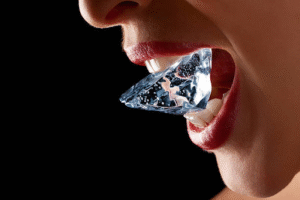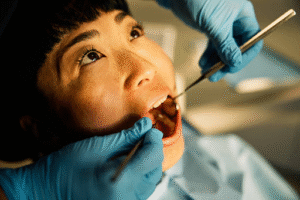
It’s a curious habit, isn’t it? If you find yourself asking, “is chewing ice bad for your teeth?” you might also wonder why so many people do it in the first place. You’re not alone! The urge to chew ice is surprisingly common, and it can stem from various reasons, both behavioral and sometimes even health-related. Understanding these can help you address the habit and minimize the chewing ice dental risks.
Here are some reasons why people chew ice and why it’s indeed a problem:
- Behavioral Reasons:
- Stress Relief: For some, the crunching sensation provides a form of stress relief or a way to cope with anxiety.
- Habit/Boredom: It can simply be a mindless habit developed over time, especially when bored or focused on other tasks.
- Thirst/Coolness: After finishing a drink, the remaining ice can offer a lingering sensation of coolness or hydration.
- Common Misconceptions:
- “It’s just water, so it’s harmless!”: This is the biggest misconception. While ice is frozen water, its hard, brittle, and cold nature makes it very dangerous for your teeth, which are designed to chew food, not hard, unyielding substances. This significantly increases the chewing ice dental risks.
- “My teeth are strong; they can handle it!”: Even healthy, strong teeth are not immune to the forces exerted when biting down on something as rigid as ice. Repeated stress leads to serious damage from eating ice.
- Potential Health Links (Pica): In some cases, a persistent craving to chew ice (a condition called pagophagia) can be a sign of an underlying medical condition, most commonly iron-deficiency anemia. If you have an intense, uncontrollable urge to chew ice, it’s worth discussing this with your general doctor, as it points to a deeper issue than just the damage from eating ice.
Regardless of the reason, the fact remains that chewing ice is problematic for your dental health. The continuous impact and temperature changes pose significant chewing ice dental risks, leading to various forms of damage from eating ice. At Smiles for Health DDS, we often see the direct consequences of this habit, and we assure you, is chewing ice bad for your teeth is absolutely true. Understanding the “why” can be the first step to breaking the habit and protecting your smile. We’re here to help you identify and overcome habits that harm your teeth as part of our commitment to wellness dentistry.
What Happens to Your Teeth When You Chew Ice?
So, you’ve established that “is chewing ice bad for your teeth” is a valid question, and yes, it is. But what exactly happens in your mouth when you crunch down on those frozen cubes? The chewing ice dental risks are real and can lead to immediate or gradual damage that impacts your oral health. The short answer is: nothing good! At Smiles for Health DDS, we’ve seen firsthand the various ways damage from eating ice can manifest, confirming that chewing ice dental risks are a serious concern.
Here’s a breakdown of what happens to your teeth when you chew ice:
- Enamel Cracks (Microfractures): Your tooth enamel, while incredibly strong, is also brittle. When you bite down hard on ice, the extreme force and cold can create tiny, hairline cracks in the enamel. You might not see them right away, but these microfractures weaken the tooth structure, making it more susceptible to further damage and decay. This is direct damage from eating ice.
- Chipped Teeth: Larger pieces of ice or repeated stress can lead to more significant damage, resulting in visible chips in your enamel. These chips can range from small, cosmetic issues to larger fractures that expose the sensitive dentin underneath, causing pain and sensitivity. This is another clear instance of damage from eating ice.
- Gum Irritation/Damage: The hard, sharp edges of ice can also injure your gum tissue. This can lead to cuts, inflammation, or even receding gums over time, exposing the tooth roots and increasing sensitivity. This contributes to chewing ice dental risks beyond just the tooth itself.
- Damage to Existing Dental Work: If you have dental fillings, dental crowns, veneers, or other restorative dental work, chewing ice puts immense pressure on them. This can cause fillings to crack or fall out, crowns to fracture, or veneers to chip off. Such damage often requires costly repairs or replacements, highlighting the chewing ice dental risks.
- Temperature Sensitivity: The extreme cold of ice can also trigger or worsen tooth sensitivity, especially if you already have exposed dentin or thin enamel. Repeated exposure can further aggravate these issues.
The accumulated damage from eating ice contributes to long-term dental problems, proving again that is chewing ice bad for your teeth. Even if you don’t feel immediate pain, the micro-damage is often occurring. That’s why it’s crucial to break this habit to protect your smile. Our team at Smiles for Health DDS can assess any existing damage and guide you toward healthier habits during your exams and cleanings.

Can Chewing Ice Cause Long-Term Dental Issues?
You might be thinking, “Okay, so is chewing ice bad for your teeth in the short term, but will it really cause lasting problems?” The answer is a definite yes. The cumulative effects of consistent chewing on ice can lead to serious, long-term dental issues that are often costly and extensive to fix. At Smiles for Health DDS, we frequently see patients grappling with the consequences of this habit years down the line, requiring significant restorative procedures, directly due to chewing ice dental risks.
Here’s how chewing ice can cause long-term dental issues:
- Increased Cavity Risk: The hairline cracks and chips in enamel created by chewing ice make your teeth more vulnerable to decay. Bacteria and acids can easily penetrate these weakened areas, leading to cavities that will eventually require dental fillings. If left untreated, these can progress to needing a root canal or even dental extractions, all as a result of damage from eating ice.
- Tooth Fractures and Breaks: Over time, repeated stress from chewing ice can lead to larger cracks or even complete tooth fractures. A severely fractured tooth may require a dental crown to save it, or in the worst cases, it might need to be extracted and replaced with a dental implant or dental bridge. This is severe damage from eating ice.
- Damage to Dental Work: Existing dental bonding, onlays and inlays, veneers, and other restorations are not designed to withstand the extreme forces of chewing ice. This can lead to them breaking, loosening, or falling out, necessitating costly repairs or replacements over and over again, further cementing the chewing ice dental risks.
- Gum Recession and Sensitivity: The trauma to gum tissue from biting on ice can lead to the gums pulling away from the teeth (gum recession). When the gums recede, the sensitive root surfaces become exposed, leading to chronic pain and increased risk of root decay. This can impact your overall oral cancer screenings as well, as gum health is part of the assessment, and this is another type of damage from eating ice.
- Jaw Pain and TMJ Issues: The excessive force and unnatural chewing motions involved in crunching ice can strain your jaw joints (temporomandibular joints or TMJ), leading to chronic jaw pain, headaches, and even TMJ/TMD treatment might be necessary. This is yet another long-term chewing ice dental risk.
The damage from eating ice is cumulative, meaning each time you chew it, you’re adding to the stress on your teeth. Preventing these long-term issues is why we strongly advise against this habit, emphasizing again that is chewing ice bad for your teeth. If you’re struggling to stop chewing ice or are concerned about existing damage, our team at Smiles for Health DDS can help. We can assess your oral health during exams and cleanings and provide solutions to restore your smile, perhaps even a full smile makeover if the damage is extensive. For personalized advice and to protect your long-term dental health, please contact us today. We’re just a phone call away!
Are Certain People More at Risk for Ice-Chewing Damage?
When we ask, “is chewing ice bad for your teeth?”, the answer is universally yes for everyone. However, some people face an even higher risk of severe damage from eating ice. If you fall into certain categories, the chewing ice dental risks are magnified, making it even more crucial to break this habit. At Smiles for Health DDS, we want to make sure everyone understands their individual risk factors so they can protect their smile effectively.
Here’s who is more at risk for ice-chewing damage:
- People with Orthodontic Appliances (Braces, Aligners): If you have braces, Invisalign, SureSmile Aligners, or other clear teeth aligners, chewing ice is an absolute no-go. The hard ice can bend wires, break brackets, or crack aligners, leading to painful emergencies and expensive repairs that set back your treatment timeline. This significantly increases chewing ice dental risks for orthodontic patients.
- Individuals with Dental Restorations: Anyone with dental fillings, dental crowns, veneers, dental bonding, or onlays and inlays is at much higher risk for damage from eating ice. These materials, while strong, are not designed to withstand the biting force against brittle ice, and can easily chip, crack, or become dislodged, requiring costly replacement.
- Those with Existing Enamel Damage: If you already have weakened enamel due to acid erosion, teeth grinding (TMJ/TMD treatment can help with grinding), or previous trauma, your teeth are even more susceptible to severe damage from eating ice. The microfractures caused by chewing ice will propagate much faster in compromised enamel.
- People with Sensitive Teeth: Chewing ice can exacerbate existing tooth sensitivity, leading to sharp, uncomfortable pain. This is a direct chewing ice dental risk. If your teeth already react to cold, ice chewing will make it worse.
- Patients with Dental Implants or Bridges: While dental implants and dental bridges are incredibly durable, they are still vulnerable to extreme forces. Chewing ice puts undue stress on these restorations and the surrounding natural teeth, potentially leading to complications or failure.
If you recognize yourself in any of these categories and find yourself asking “is chewing ice bad for your teeth?” as you crunch, please take this warning seriously. The chewing ice dental risks are simply too high. Our team at Smiles for Health DDS can assess your oral health and discuss strategies to break this habit, promoting your overall wellness dentistry. Contact us for a check-up!
What Are Safer Alternatives to Chewing Ice?
If you’re now convinced that “is chewing ice bad for your teeth” leads to a definite yes, but you still crave that satisfying cold crunch, don’t worry! There are plenty of safer alternatives that can satisfy your craving without the severe chewing ice dental risks. At Smiles for Health DDS, we understand that habits are hard to break, and finding a healthy substitute is often the key to preventing long-term damage from eating ice.
Here are some safer alternatives to chewing ice that can protect your smile:
- Crushed Ice: If it’s the cold sensation you love, try using finely crushed ice. This is much softer than solid cubes and significantly reduces the impact and stress on your teeth. Some refrigerators have a crushed ice dispenser for this very reason!
- Suck, Don’t Chew: Allow ice chips or small pieces to melt in your mouth rather than crunching down on them. This gives you the cold sensation without the damaging force.
- Cold, Crunchy Fruits and Vegetables:
- Frozen Grapes: These are a fantastic option! They’re cold, slightly chewy, and provide a satisfying pop without the hardness of ice.
- Cold Carrot Sticks or Celery: The crunch is there, and they’re fibrous, which can even help clean your teeth.
- Chilled Apple Slices: Crisp and refreshing, offering a healthy crunch.
- Frozen Yogurt Bites or Fruit Puree Cubes: Freeze small portions of yogurt or fruit puree in ice cube trays for a soft, flavorful, and cold treat that won’t harm your teeth.
- Hard Candies (Sugar-Free): If it’s the sensation of something solid in your mouth, a sugar-free hard candy can be a safer alternative. Just remember to suck, not chew, them.
- Chill Your Water: Keep your water bottle in the fridge for a constant supply of cold, refreshing water without the need for ice.
Breaking the habit of chewing ice can take time and effort, but finding a suitable replacement can make it much easier. These quick recovery tips for extraction apply to prevention too! By opting for these safer alternatives, you can drastically reduce the chewing ice dental risks and prevent damage from eating ice. Our team at Smiles for Health DDS is always ready to discuss healthy habits during your exams and cleanings to keep your smile healthy and strong, embracing total wellness dentistry.

Should You See a Dentist If You’ve Been Chewing Ice Often?
You’ve learned that “is chewing ice bad for your teeth” is not a myth, and you’re aware of the chewing ice dental risks and potential damage from eating ice. If you’ve been a frequent ice chewer, you might be wondering if it’s too late or if you should schedule a visit to the dentist. The answer is a resounding yes! Even if you don’t feel immediate pain, regular ice chewing can cause silent damage that can escalate into significant problems over time. At Smiles for Health DDS, we strongly recommend a professional evaluation.
Here are signs of damage to discuss with your provider, indicating you should see a dentist:
- Increased Tooth Sensitivity: If you notice your teeth are more sensitive to hot, cold, or sweet foods and drinks, especially if it’s a new or worsening symptom, it could indicate micro-cracks in your enamel or exposed dentin caused by chewing ice.
- Visible Chips or Cracks: Even small chips on the edges of your teeth or visible cracks (sometimes appearing as faint lines) mean damage from eating ice has occurred. These can worsen and lead to more serious fractures if left untreated.
- Loose or Damaged Fillings/Crowns: If any of your existing dental fillings, dental crowns, veneers, or other restorations feel loose, have fractured, or have fallen out, this is a clear sign of chewing ice dental risks taking their toll.
- Jaw Pain or Headaches: Chronic jaw pain, clicking or popping sounds when you open or close your mouth, or frequent headaches can be symptoms of strain on your temporomandibular joint (TMJ) caused by excessive force from chewing ice. This might require TMJ/TMD treatment.
- Gum Recession: If you notice your gums pulling away from your teeth, exposing more of the tooth surface, this could be partly due to the trauma of chewing ice. Exposed roots lead to sensitivity and are more prone to decay.
- Dull Tooth Pain or Aches: A persistent, dull ache in your teeth or jaw, even without sensitivity, can indicate underlying stress or damage to the tooth structure.
During your visit, our team at Smiles for Health DDS will perform a thorough examination, including X-rays, to assess the extent of any damage from eating ice. We can identify cracks, evaluate your restorations, and discuss strategies to help you break the habit. Early detection and intervention can prevent minor issues from becoming major, costly problems like needing dental extractions or complex dental implants. Don’t wait for severe pain; if you’ve been chewing ice often, proactive care is key to your wellness dentistry. Contact us today to schedule your comprehensive check-up.
Frequently Asked Questions
Is chewing ice bad for your teeth and why?
Yes, chewing ice is bad for your teeth because it can cause cracks, chips, and enamel damage. Smiles for Health DDS explains the chewing ice dental risks and how damage from eating ice impacts oral health.
What are the common chewing ice dental risks?
Common chewing ice dental risks include enamel fractures, tooth sensitivity, and damage to dental restorations. Smiles for Health DDS emphasizes these as serious concerns related to is chewing ice bad for your teeth.
Can chewing ice lead to tooth fractures or breaks?
Yes, the hardness of ice can cause cracks or breaks in teeth. Smiles for Health DDS advises avoiding ice to minimize damage from eating ice.
Does chewing ice increase tooth sensitivity?
Yes, chewing ice can wear down enamel and expose dentin, leading to increased sensitivity. Smiles for Health DDS highlights this as a significant chewing ice dental risk.
Are dental fillings or crowns more susceptible to damage from chewing ice?
Yes, dental work like fillings and crowns can chip or crack from chewing ice. Smiles for Health DDS recommends extra caution if you have restorations to prevent damage from eating ice.
Can chewing ice worsen existing dental problems?
Yes, chewing ice can exacerbate cavities, gum disease, or cracked teeth. Smiles for Health DDS stresses avoiding ice to protect oral health and prevent further chewing ice dental risks.
Is there any safe way to chew ice without damaging teeth?
Chewing ice is generally not safe for teeth. Smiles for Health DDS suggests alternatives like crushed ice or cold drinks without chewing to avoid damage from eating ice.
Can chewing ice be a sign of nutritional deficiencies?
Yes, craving ice (pagophagia) may indicate anemia or iron deficiency. Smiles for Health DDS encourages addressing underlying health issues to reduce harmful chewing ice habits.
How can I stop the habit of chewing ice to protect my teeth?
Identifying triggers, substituting with safer snacks, and consulting your dentist can help. Smiles for Health DDS provides strategies to break the habit and reduce chewing ice dental risks.
What should I do if I suspect damage from chewing ice?
Visit your dentist promptly for evaluation and treatment. Smiles for Health DDS can assess chewing ice dental risks and repair damage from eating ice.
Does chewing ice cause jaw pain or headaches?
Yes, the repetitive chewing motion can strain jaw muscles and cause discomfort related to damage from eating ice.
Are children more vulnerable to damage from chewing ice?
Yes, children’s teeth are more fragile and susceptible to chewing ice dental risks.
Can chewing ice lead to tooth wear over time?
Yes, repeated ice chewing wears down enamel, increasing the risk for decay and damage from eating ice.
How long does damage from chewing ice take to appear?
Damage can accumulate over months to years, depending on frequency and force, increasing chewing ice dental risks.
Are there dental treatments to fix damage caused by chewing ice?
Yes, treatments include bonding, crowns, and veneers to restore damaged teeth caused by damage from eating ice.







